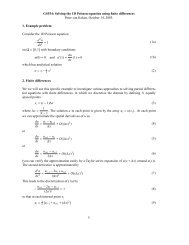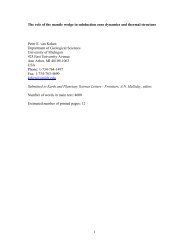Quantitative paleoenvironmental and paleoclimatic reconstruction ...
Quantitative paleoenvironmental and paleoclimatic reconstruction ...
Quantitative paleoenvironmental and paleoclimatic reconstruction ...
You also want an ePaper? Increase the reach of your titles
YUMPU automatically turns print PDFs into web optimized ePapers that Google loves.
ARTICLE IN PRESS<br />
N.D. Sheldon, N.J. Tabor / Earth-Science Reviews xxx (2009) xxx–xxx<br />
15<br />
extensive evidence to suggest that O 2 levels increased substantially at<br />
~2.3 Ga ago (various; Bekker et al., 2004 <strong>and</strong> references therein).<br />
Underst<strong>and</strong>ing the “faint young Sun” paradox is one of the fundamental<br />
questions in Earth Sciences, because with significantly reduced<br />
solar insolation, the Earth should have been completely glaciated if<br />
there was not significantly higher levels of greenhouse forcing than at<br />
present (Kasting, 1993).<br />
As will be discussed further below in Section 6.2, one of the<br />
difficulties of reconstructing CO 2 <strong>and</strong> CH 4 levels is to divorce the<br />
method from assumptions about precisely what level of oxygen was<br />
present. For example, Holl<strong>and</strong> <strong>and</strong> Zbinden (1988) discuss a method<br />
that looks at the balance between O 2 <strong>and</strong> CO 2 as indicated by<br />
weathering processes in a ~1.1 Ga old paleosol in the form of a ratio<br />
between CO 2 <strong>and</strong> O 2 consumption. Of potentially wider applicability<br />
is a method for calculating CO 2 levels that is independent of<br />
any assumptions about the atmospheric O 2 level. Sheldon (2006b)<br />
presented such a model based on mass-balance calculations (see<br />
Section 5.3.1) of silicate weathering that related elemental weathering<br />
to atmospheric CO 2 levels.<br />
During silicate weathering, total CO 2 consumption can be approximated<br />
by the following reactions:<br />
MgO þ 2CO 2 þ H 2 O→Mg 2þ þ 2HCO − 3<br />
CaO þ 2CO 2 þ H 2 O→Ca 2þ þ 2HCO − 3<br />
Na 2 O þ 2CO 2 þ H 2 O→2Na þ þ 2HCO − 3<br />
K 2 O þ 2CO 2 þ H 2 O→2K þ þ 2HCO − 3<br />
ð16Þ<br />
ð17Þ<br />
ð18Þ<br />
ð19Þ<br />
where, for example, each mole of base cation (e.g., MgO) liberated<br />
requires two moles of CO 2 (e.g., Holl<strong>and</strong> <strong>and</strong> Zbinden, 1988). Although<br />
other elements are weathered, with few exceptions (e.g., a quartz<br />
arenite) the parent rock concentration of the bases in reactions (17–<br />
20) are at least 1–2 orders of magnitude larger than any other mobile<br />
element. Because K may be remobilized metasomatically <strong>and</strong> accumulated<br />
in paleosols after burial (e.g., Maynard, 1992), it has to be<br />
dealt with differently than Ca, Mg, <strong>and</strong> Na, typically by assuming that K<br />
mass transfer values should be equal to Na mass transfer values or<br />
potentially, by using Eq. (14).<br />
Mass transfer values (Eq. (12)) for each of those individual cations<br />
can be transformed into mass fluxes as follows:<br />
<br />
m j;flux gcm − 2<br />
= ρ p<br />
C j;p<br />
100<br />
Z = D<br />
Z j;w<br />
Z =0<br />
τ j;w ðÞ z dZ<br />
ð20Þ<br />
where Z is the depth in the soil profile <strong>and</strong> D j,w is the total depth of the<br />
profile (e.g., Chadwick et al., 1990). Given that many Precambrian<br />
paleosols have been deeply buried <strong>and</strong> show evidence of significant<br />
compaction (e.g., Retallack, 1986 showed ptygmatically folded quartz<br />
dikes), it is necessary to decompact the paleosols to their original<br />
thickness D j,w using Eq. (4). After the compaction-corrected mass<br />
fluxes are calculated for each individual base cation <strong>and</strong> coverted to<br />
moles, because 2 mol of CO 2 are required to liberate each mole of base<br />
cation (Eqs. 17–20) the total flux of CO 2 required for the observed<br />
weathering (M) is given by:<br />
<br />
<br />
M mols CO 2 cm − 2 =2 X m j; flux ð21Þ<br />
Soils do not form instantaneously, so to calculate a true flux value,<br />
M must be divided by time (T). With limited biological productivity as<br />
in the Precambrian, the time-averaged flux (M/T) is a product of two<br />
distinct sources of CO 2 ,CO 2 in the atmosphere being added by rainfall<br />
to the soils (X rain ), <strong>and</strong> CO 2 added by direct diffusion into the soils<br />
(X diff ). Holl<strong>and</strong> <strong>and</strong> Zbinden (1988) quantified X rain <strong>and</strong> X diff as<br />
follows:<br />
M<br />
<br />
T mol cm − 2 yr − 1<br />
K CO2 r<br />
= X rain + X diff ≈pCO 2 + κ D <br />
CO 2<br />
α<br />
10 3 L<br />
ð22Þ<br />
where pCO 2 is the partial pressure of atmospheric CO 2 (atm), K CO2 is<br />
the Henry's Law constant for CO 2 , r is rainfall rate (cm yr − 1 ), D CO2 is<br />
the diffusion constant for CO 2 in air (0.162 cm 2 s − 1 ; CRC H<strong>and</strong>book),<br />
α is the ratio of diffusion constant for CO 2 in soil divided by the<br />
diffusion constant for CO 2 in air (discussed below), L is the depth to<br />
the water table, <strong>and</strong> κ is a constant which is the ratio of seconds in a<br />
year divided by the number of cm 3 per mol of gas at st<strong>and</strong>ard<br />
temperature <strong>and</strong> pressure (1.43×10 3 (s cm 3 )/(mol year)). There is no<br />
explicit term including any CO 2 processes involving a terrestrial<br />
biosphere (i.e., it is assumed to play a negligible role), a point that was<br />
further discussed by Sheldon (2006b), but which is a reasonable<br />
simplifying assumption (however, see Yapp <strong>and</strong> Poths, 1993). Eq. (23)<br />
also assumes that the CO 2 diffusion constant <strong>and</strong> gradient are constant<br />
with depth, <strong>and</strong> that the partial pressure of atmospheric CO 2 is much<br />
larger than the partial pressure of CO 2 at the water table (depth=L).<br />
Eq. (23) can be rearranged to solve for atmospheric pCO 2 as follows:<br />
M<br />
pCO 2 = h i<br />
T K CO r 2<br />
+ κ D ð23Þ<br />
CO α 2<br />
10 3 L<br />
Thus, by quantifying M using direct measurements of paleosol mass<br />
balance <strong>and</strong> estimating T <strong>and</strong> L, it is possible to calculate the partial<br />
pressure of atmospheric CO 2 at the time the paleosols formed. Sheldon<br />
(2006b <strong>and</strong> supplemental materials) discusses the uncertainties in the<br />
model assumptions, but in general, only T is poorly constrained <strong>and</strong><br />
makes a significant (N10%) difference to the calculated pCO 2 value.<br />
Among the results of applying this mass-balance paleobarometer<br />
were that the pCO 2 value ~2.2 Ga ago was 23 ×3<br />
3 times present<br />
atmospheric levels (PAL), an amount insufficient to overcome the<br />
“faint young Sun” paradox at that time, that similar pCO 2 values<br />
persisted until at least 1.8 Ga ago, <strong>and</strong> that much lower pCO 2 values<br />
were present by 1.1 Ga ago (Sheldon, 2006b). Each of those<br />
conclusions was based on analysis of multiple contemporaneous or<br />
near-contemporaneous paleosols. The finding that pCO 2 levels at<br />
~2.2 Ga ago were insufficient to overcome the “faint young Sun”<br />
paradox is further supported by atmospheric modeling results (Pavlov<br />
et al., 2000, 2003), which also suggest the need for an additional<br />
greenhouse gas such as CH 4 . The third conclusion, of relatively low<br />
pCO 2 levels (b10 PAL) ~1.1 Ga ago is also supported by recent results<br />
from a completely independent proxy, a paleobarometer derived from<br />
calcified cyanobacteria (Kah <strong>and</strong> Riding, 2007). Thus, if a reasonable<br />
estimate for T may be made, then this method appears to be very<br />
useful for estimating Precambrian pCO 2 .<br />
5.4. Paleotemperature<br />
In addition to isotopic paleothermometers (see Section 7 below),<br />
there have been recent attempts to develop paleothermometry based<br />
on empirical relationships relating mean annual temperature (MAT)<br />
to the geochemical composition of modern soils. Using data from<br />
Marbut (1935) <strong>and</strong> modern measurements of MAT, Sheldon et al.<br />
(2002) proposed the following relationship between MAT <strong>and</strong><br />
salinization of a Bw or Bt horizon (Table 3):<br />
Tð ○ CÞ = − 18:5S +17:3 ð24Þ<br />
Please cite this article as: Sheldon, N.D., Tabor, N.J., <strong>Quantitative</strong> <strong>paleoenvironmental</strong> <strong>and</strong> <strong>paleoclimatic</strong> <strong>reconstruction</strong> using paleosols, Earth-<br />
Science Reviews (2009), doi:10.1016/j.earscirev.2009.03.004















